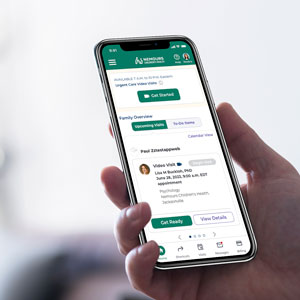Tissue Engineering/Regenerative Medicine Lab
About Tissue Engineering & Regenerative Medicine (TERM) Lab
As part of the Nemours Children's Center for Pediatric Clinical Research and Development, our lab focuses on cellular-level engineering with applications involving the heart and nerve and muscle cells in children with cerebral palsy.
Lab Head
As head of the TERM Lab, Dr. Akins directs multiple research efforts addressing problems relating to the replacement or regeneration of tissues for children affected by a range of genetic, congenital and acquired diseases. Using advanced cell-biological, biochemical and tissue engineering techniques, the TERM Lab is working with physicians from several clinical divisions (including Anesthesiology and Critical Care, Cardiothoracic Surgery, Orthopedics, Pediatrics and General Surgery) to seek advanced approaches to pediatric diseases and conditions. In addition, Dr. Akins serves on several departmental and hospital committees including the Research Review Committee and the Hospital Safety Committee. He chairs both the Institutional Biosafety Committee and the Research Safety Committee.
Current Research Group
- Michael D. Bruner, MS
- Kara L. Gratton, MS
- Therese A. McLaughlin
- Christian Pizarro, MD
Our Location
Nemours Children’s Hospital, Delaware
1600 Rockland Road
Wilmington, DE 19803
Phone: (302) 651-6800
Fax: (302) 651-6897
Current Research Interests & Projects
Our lab focuses on cellular-level engineering with applications involving the heart and nerve and muscle cells in children with cerebral palsy.
Cardiac Tissue Engineering
Investigators
Background
A significant number of children are born with cardiac malformations, and about 25,000 children per year undergo some type of corrective surgery for congenital heart defects. In addition, children with certain types of infectious or acquired diseases lose cardiac function when portions of the heart are damaged. Experience has shown that the heart has a limited ability to repair itself. Surgical and/or medical management are usually required to treat patients with severe cardiac problems, and treatments for both structural and functional problems have become highly advanced, but, when they fail, whole organ replacement remains the only other option. At present, heart transplantation is limited by both the number of donors and by the limited life-span of implanted organs.
What We're Doing
We are working toward the development of tissue-engineered cardiac replacements for use in the repair of congenitally under-developed or damaged tissue. Our current research efforts are designed to investigate the cellular organization of the heart and to study how aspects of this organization can be re-established in culture using specialized bioreactors. To do this, we are using a combination of cell biological, molecular and surgical approaches. We use fluorescent labeling to quantify the amount of vimentin and actin (proteins found cardiac cells) and to identify cells of a particular type in our cultures.
Some of What We've Found
We have found that isolated cardiac cells can regenerate aspects of the three-dimensional architecture seen in the heart. We think that it may be possible to take advantage of this intrinsic organizational ability to construct cardiac tissue equivalents in the lab. Although there is a large amount of work that needs to be done, we hope that cardiac tissue engineering will provide a source of implantable material for surgeons to use in the treatment of congenital and acquired diseases of the heart. In the long run, we hope to improve our understanding of the basic cell biology associated with cardiac structure and to increase the number of patients that can be treated for a host of heart diseases.
Neuromuscular Junctions in Cerebral Palsy (CP)
Investigators
Background
This study is part of a larger research effort to understand the pathophysiology of nerve-muscle interactions in children with neurologic injuries and diseases. Overall, we are interested in studying the structural and functional perturbations that may occur at neuromuscular junctions (NMJs) as a result of neurologic insult or deficit. In this study we look at NMJs in children with CP. We think that children with CP may have intrinsic abnormalities in their neuromuscular junctions, and we are attempting to understand the extent and nature of this pathophysiology by studying aspects of the structure and function of neuromuscular junctions.
Cerebral Palsy
Studies show that, in recent years, the prevalence of cerebral palsy is on the rise, and CP is the most common neurologic condition in children. It is a disorder of the central nervous system in which an insult sustained in fetal or early neonatal life results in spasticity and motor dysfunction. The effects on the motor system, clinically, are similar to those seen in the adult disease states of stroke, closed-head injury, encephalitis and spinal cord injury. Despite the similarities in motor dysfunction seen in CP and other neurological conditions, few investigations have been conducted to examine the nerve-muscle interactions in children with CP, so we are establishing a research program to begin studying these interactions.
Neuromuscular Junctions
The surface of skeletal muscle contains proteins called acetylcholine receptors (AChRs). In the normal state, AChRs are confined to the area on the muscle that is contacted by a nerve. This area is called the neuromuscular junction. When a person wishes to contract a muscle, the nerve fires, and a small amount of a chemical messenger called acetylcholine is deposited at the neuromuscular junction. The AChR "sees" this chemical and induces the muscle to contract. Another protein at the neuromuscular junction, called acetylcholine esterase, chops up the chemical messenger so that there is none left at the junction. Normally, these two proteins are found together and only at neuromuscular junctions. Neurological diseases in adults that cause spasticity, such as stroke, closed head injury, encephalitis and spinal cord injury, all lead to abnormal neuromuscular junctions that are characterized by the appearance of AChRs away from their normal localization, and we think that this may be true in children with CP as well.
What We're Doing
Children with CP undergo a large number of surgical procedures, and, after getting the permission of the child’s parent, we are using small pieces of muscle that are collected during scheduled surgeries. We use a method to stain these pieces of muscle so that we can see where the acetylcholine receptor and the acetylcholine esterase proteins are located. The first thing we did was to compare the staining patterns found in muscle taken from children with CP to those found in children without CP to see if there were differences.
Some of What We've Found
In children undergoing surgeries to correct scoliosis, we have found that those who do not have CP have neuromuscular junctions in which the acetylcholine receptor (AChRs) and acetylcholine esterase (AChEase) proteins localize in the same spots. Using low power images taken through a specialized microscope, we can see if there are areas where the AChR occurs without the AChEase. In children with CP, a significant subset of children have abnormal staining patterns and non-junctional AChRs.
Contact TERM Lab
Phone: (302) 651-6800
Fax: (302) 651-6897
Nemours Children’s Hospital, Delaware
1600 Rockland Road
Wilmington, DE 19803

